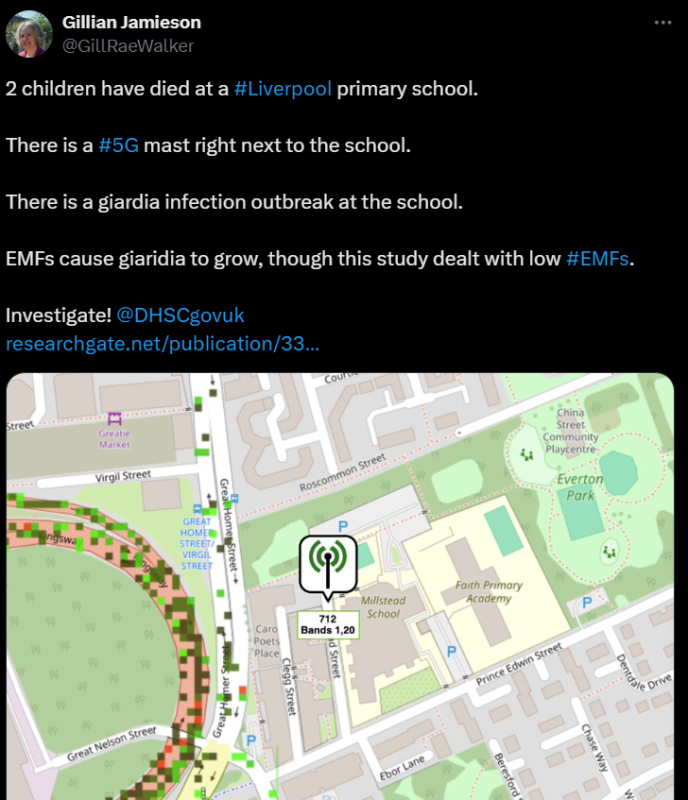
Understanding the Impact of Non-Ionizing Radiation on Microbial Growth and Human Health

The intriguing relationship between non-ionizing radiation (NIR) and microbial behavior has significant implications, particularly as our exposure to electromagnetic fields (EMFs) continues to increase due to technological advancements. Recent studies, including one focused on the protozoan Giardia lamblia, reveal that NIR can alter the growth rates of microbes, potentially affecting human health, especially in vulnerable populations such as children.
The Influence of NIR on Giardia lamblia and Health Implications
Giardia lamblia is a waterborne protozoan that causes giardiasis, characterized by symptoms such as diarrhea, abdominal pain, and weight loss. Research indicating that low-frequency electromagnetic fields can promote the growth of this parasite suggests potential health risks, particularly in environments with high NIR exposure.
Impact on Public Health
Increased growth of Giardia lamblia due to NIR could lead to more severe or prolonged outbreaks of giardiasis. This is especially concerning for children, who are more susceptible to the infection and its effects. Understanding this relationship is crucial for developing better public health strategies and interventions to protect those most at risk.
Broader Effects of NIR on Microbial Behavior
The interaction between NIR and microbes extends beyond Giardia lamblia. Studies have explored the effects of electromagnetic fields on a variety of bacteria and fungi, with findings that have significant implications for health and environmental management.
Bacterial Responses to NIR
Research has demonstrated variable responses of bacteria to NIR exposure, with some bacteria showing inhibited growth while others flourish. These effects could influence the effectiveness of antibiotics, the control of bacterial infections, and even the processes of decomposition and waste management.
Fungal Growth and NIR
Like bacteria, fungi exhibit diverse responses to NIR. Certain frequencies can suppress or enhance fungal growth. This has implications for industries concerned with food preservation, building maintenance, and health care, particularly regarding the management of mold and airborne pathogens.
Potential Link Between NIR and Lyme Disease
Lyme disease, caused by the bacterium Borrelia burgdorferi, is a complex condition often accompanied by various coinfections. While direct evidence linking NIR to Lyme disease is lacking, the potential of NIR to modulate immune responses or influence microbial coinfections warrants further investigation.
Immune System Interactions
NIR may affect how the immune system responds to infections, potentially altering the body’s ability to fight Lyme disease and other microbial infections.
Influence on Coinfections
Considering that NIR can affect microbial growth, it’s plausible that NIR exposure could alter the dynamics of coinfections in Lyme disease, potentially impacting disease progression and treatment outcomes.
The Need for Comprehensive Research and Updated Guidelines
Given the growing evidence of NIR’s impact on microbial growth and the potential health implications, there is a pressing need for more comprehensive research. This research should aim to clarify the conditions under which NIR affects microbes and assess the broader health implications of these effects.
Updating Health Guidelines
As our understanding of NIR’s biological effects expands, it’s crucial that health guidelines and safety standards are revisited and updated to reflect these findings. Protecting public health in the age of ubiquitous electromagnetic exposure will require policies that are informed by the latest scientific insights.
FAQs on NIR and Microbial Growth
- What is non-ionizing radiation?
- Non-ionizing radiation refers to radiation that does not have enough energy to remove electrons from atoms, including UV light (that doesn’t ionize), visible light, infrared, microwaves, and radio frequencies.
- How does NIR affect microbes like Giardia lamblia?
- Studies suggest that NIR can enhance the growth of certain microbes, such as Giardia lamblia, potentially leading to increased infection rates and severity.
- Can NIR influence the course of diseases like Lyme disease?
- While direct connections between NIR and Lyme disease are not yet established, NIR’s potential to affect microbial behavior and immune responses suggests it could influence disease dynamics, especially regarding coinfections.
- What should public health officials do in response to these findings?
- Public health policies should consider the latest research on NIR and microbial growth, updating guidelines and safety standards to protect against potential health risks, especially for vulnerable populations like children.
The Crucial Findings from Animal Studies and Their Implications for Human Health
Recent studies by prominent organizations like the National Toxicology Program (NTP) and the Ramazzini Institute (RI) have stirred significant concern and debate regarding the safety of radiofrequency radiation (RFR) emitted by cell phones and other wireless devices. The results from these studies show a disturbing correlation between RFR exposure and the development of cancerous tumors in animal models—findings that cannot be ignored in the context of public health.
Scientific Evidence from NTP and RI Studies
The NTP study found a clear link between high levels of RFR exposure and the development of malignant heart tumors, brain tumors, and adrenal gland tumors in rats. This was further corroborated by the RI study, which found similar results at lower RFR exposure levels, suggesting that even everyday exposure to RFR could pose a risk.
Morphological Similarities Between Rat and Human Tumors
One of the most compelling aspects of these studies is the morphological similarity between the tumors found in rats and those seen in human gliomas. This similarity strongly suggests that the biological effects observed in rats could be reflective of potential effects in humans. These findings bridge the gap between animal and human studies, reinforcing the relevance of animal data in understanding human health risks.
The Genetic Impact of RFR
Further studies have gone beyond morphological comparisons and have delved into the genetic alterations caused by RFR. Researchers have used next-generation sequencing panels to analyze genes associated with human gliomas in the tumors of rats exposed to RFR. These studies have uncovered specific genetic mutations that are known to play a role in human cancers, thereby providing a molecular basis for the carcinogenic potential of RFR.
Public Health Concerns and Policy Implications
The evidence from these studies has profound implications for public health policies. The potential carcinogenic effects of RFR, underscored by detailed genetic and morphological evidence, demand a reassessment of current safety standards and regulatory guidelines which have not been significantly updated in over 25 years.
Call for Action: Rethinking RFR Guidelines and Safety Standards
Given the mounting evidence from animal studies and their implications for human health, there is an urgent need for regulatory bodies to update safety guidelines for RFR exposure. This is not just about acknowledging the scientific findings but about taking proactive steps to protect public health, especially the vulnerable populations such as children who are more susceptible to environmental hazards.
FAQs About RFR and Public Safety
- What does the similarity between rat and human tumors mean for public health?
- The similarity suggests that RFR could have similar carcinogenic effects in humans, emphasizing the need for precautionary measures in the use of wireless technology.
- How do genetic findings in rats relate to human health risks?
- Genetic changes observed in rat tumors exposed to RFR mirror mutations that drive human cancers, indicating that RFR exposure could initiate or promote carcinogenesis in humans.
- What actions can the public take in light of these findings?
- The public should advocate for stricter RFR exposure regulations, support continued research in this area, and follow precautionary measures to minimize personal exposure.
- Why should we reconsider RFR safety standards now?
- The existing standards are based on outdated research that did not account for the biological effects of RFR exposure shown in recent studies.
Conclusion
The alignment of recent scientific studies with concerns about the health risks of RFR, including potential links to cancer, reinforces the need for a comprehensive review and update of public health guidelines and safety standards related to wireless technologies. It is imperative that these standards reflect the latest scientific knowledge to ensure public health is not compromised in the wake of technological advancement.







